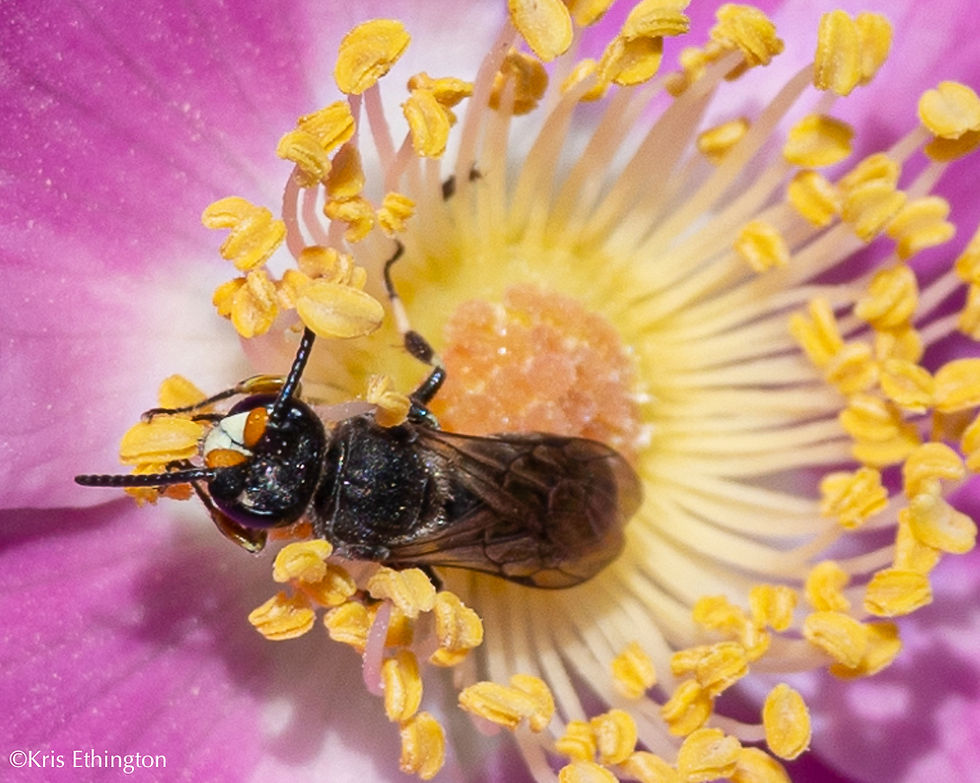Building Community Among Bee Enthusiasts
- Kris Ethington

- Jun 2, 2023
- 2 min read

Slowly but surely, spring started to emerge and like all bee nerds, enthusiasts and photographers, entomologists, and pollinator fans out there, excitement for this bee season was palpable among us.
When Ingrid Carmean, a Washington Native Bee Society (WaNBS) board director, reached out to members in the North Olympic Peninsula area where she and I live, with the proposition of participating in a new bee subgroup for the North Olympic Peninsula area, I was an enthusiastic, “Yes!”
As a member of the WaNBS, I was looking for a way to connect with fellow native bee folks in my area, gain bee species specific and regional knowledge through patient mentoring and share my own area of focus – bee photography combined with iNaturalist observations. Building a community among bee enthusiasts through in-person field trips to area parks, public gardens, and all the less obvious bee habitats was an opportunity to identify and witness early bee nesting behavior along with identification of the floral resources bee specialists and generalists utilize.

Everyone has a story about how they came to be supporters of native bees. It just happens that our North Olympic Peninsula group leader, Ingrid Carmean, is a retired entomologist who lives in Sequim/Port Angeles, whereas I’m just a bee photographer and live in Port Townsend. The two of us can serve as the WaNBS community intersect for the North Olympic Peninsula.
Our first field trip was to the Dungeness Recreation Area in Sequim led by Ingrid who had been identifying and monitoring nesting sites of some Andrena bees and had been observing the threatened Bombus occidentalis in its habitat there. We observed many bee species and some Bombus but not the illusive Western Bumble Bee. I managed to get photos of multiple species, including Andrena prunorum, entering her nest on a dry bank near a mass of Oregon Grape that served her early emergence this season.
I was charged up following this experience and decided to search out more bee nesting areas in Port Townsend. On my way home, I visited the Kah Tai Prairie Preserve to check on flowering and pollinators as this was to be our next field trip. I was rewarded after following the behavior of cuckoo bees which led me to an Andrena bee nest site. Once I understood what behaviors to look for, I began tracking other bee species to their nest sites in unassuming gravel and weedy areas outside the boundary of the prairie remnant.
After reaching out to Ingrid that evening, she decided to join me in Port Townsend the next day. Timing and temperature are everything when it comes to observing nesting behaviors in bees. We started at Kala Point to survey the beach vegetation there. We were surprised to quickly witness more nesting bees, aside from the Habropoda miserabilis (Pacific Dune-Digger) bees that I’ve been observing for a couple of years. This visit, Ingrid witnessed an industrious Habropoda female excavating her nest in the dune.

To my delight, Ingrid came equipped with her net and bee cooling supplies. I watched her collect bees at Kala Point for temporary evaluation while I photographed them and made video clips upon their release. I am so grateful to have had this unique opportunity.





"Expert tree removal services across the United States, ensuring safety, efficiency, and the preservation of your property's natural beauty. Our skilled team is committed to handling even the most challenging tree removals with precision and care. Trust us to enhance the safety and aesthetics of your surroundings. https://conroearborist.net/